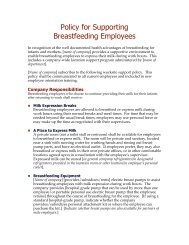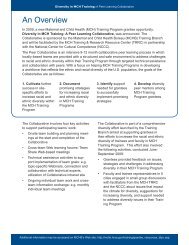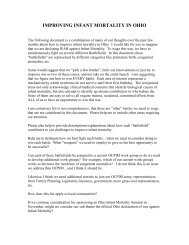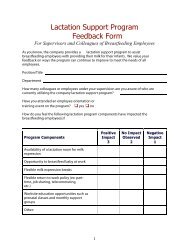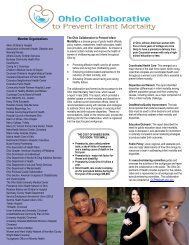A Framework for Evaluating Systems Initiatives
A Framework for Evaluating Systems Initiatives
A Framework for Evaluating Systems Initiatives
- No tags were found...
You also want an ePaper? Increase the reach of your titles
YUMPU automatically turns print PDFs into web optimized ePapers that Google loves.
North Carolina’s Smart Start is another example in the scale category. This now 14-year-old initiativewas established to build a comprehensive and coordinated early childhood system statewide <strong>for</strong>purposes of improving school readiness outcomes. The initiative offers children birth to age five arange of services with the goal of enabling children to enter school healthy and ready <strong>for</strong> success.Smart Start is funded through public dollars drawn from the state’s general fund that are then directedto local partnerships in all of North Carolina’s 100 counties (the state appropriation was $204 millionin fiscal year 2007; funding peaked at $231 million in fiscal year 2000). 25 While the majority of SmartStart funding is spent on child care or child care-related services (e.g., subsidies), about one-third oflocal partnership dollars must address other issues affecting young children and their families, such asfamily support and health care. 26V. Designing <strong>Systems</strong> Initiative EvaluationsAs the last section makes clear, all systems initiatives are not the same. It follows then that theirevaluations should not be the same. <strong>Systems</strong> initiative evaluations should be tailored to their uniquetheories of change, assessing the outcomes and impacts connected to the parts of the system they areattempting to change.The figure on the next page was developed to guide evaluation planning decisions <strong>for</strong> systemsinitiatives. Like the theory of change menu, it is organized around the five focus areas and offers ideasabout appropriate evaluation choices <strong>for</strong> initiatives that incorporate each.Each focus area features two evaluation questions that generally address:• Did the initiative do what it said it would do (in that focus area)?• Did the initiative produce the expected results (<strong>for</strong> that focus area)?The fi gur e also features possible evaluation methodologies to address those questions. These lists ofhods are not exhaustive or prescriptive. They offer ideas, but do not spell outtions should look. Those decisions must be based on a careful considerationecific initiative in question and what it is designed to do., it is important to keep in mind that most systems initiatives are hybrids ands on more than one area. Consequently, multiple evaluation questions willy and evaluations should feature a mix of design elements to address thoseions. Additionally, evaluations should identify the areas in which the initiatives the most emphasis, and plan <strong>for</strong> similar levels of evaluation emphasis inse same areas.<strong>for</strong> Law and Social Policy. North Carolina Smart Start. Retrieved on June 30, 2007 fromww.clasp.org/ChildCareAndEarlyEducation/map030707nc1.htm.n, J., Stover Wright, M., & Bruner, C. (2006). Beyond parallel play: Emerging state and community planningbuilding early learning. Des Moines, IA: State Early Childhood Policy Technical Assistance Network16A <strong>Framework</strong> <strong>for</strong> <strong>Evaluating</strong> <strong>Systems</strong> <strong>Initiatives</strong>



